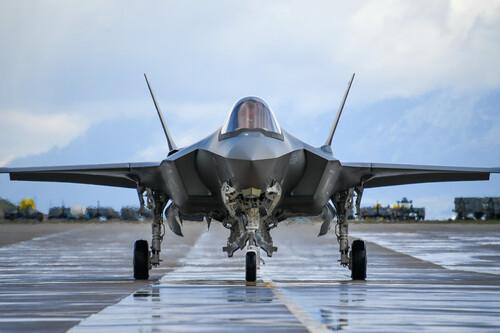Spain’s Reckless F-35 Rejection Guarantees Naval and Air Force Obsolescence

Hello everyone. Let’s talk about Spain – a country that just looked at the world’s most advanced fighter jet, the F-35, and said “Nah, we’re good. We’ll wait for the European unicorn that doesn’t exist yet.” This is the geopolitical equivalent of declining a fully loaded legendary drop in your PvP loadout because you’re holding out for a mythical weapon that might — might — arrive in 15 years. Bravo.
The Great Spanish Plot Twist
In 2019, the United States declared its Lockheed Martin F-35 ready for combat after decades of investment and drama. Spain, along with other NATO allies, had been eyeing the stealthy beast for its armed forces. Fast forward to now, and Madrid has dropped the deal, fully embracing the “Support European Defence Industry” side quest. The charm of “buy local” sounds noble… right until you realise your naval air wing is about to disappear faster than loot in a public match.
Immediate Collateral Damage: The Spanish Navy
Here’s your first dose of bad news: those Harrier jump jets Spain’s navy relies on? They retire in 2030. Other countries — including the US — have already moved on. When Spain’s go, they’re gone. No spares, no support, just fond memories and static displays in military museums. Without the F-35B, Spain loses its fixed-wing carrier capability. The Juan Carlos I — the current flagship — will be reduced to a glorified helicopter pad. Yes, you can operate choppers from it, but you’ll be going from high-altitude sniping to melee-only in one patch update. Not a good meta shift.

The “We’ll Build Something Better” Delusion
To fill the void, there’s talk of designing a carrier for conventional take-off and landing jets. Great idea… if it weren’t guaranteed to arrive fashionably late, long after the Harriers are scrap metal. By the time any “Euro-carrier” hits the water, Spain’s gap in naval air power will have become an outright chasm.
Air Force? Also in Limbo
The Spanish Air Force had quietly earmarked the F-35A as a stop-gap until the ambitious Future Combat Air System (FCAS) — the European sixth-gen jet — is ready. Which, in case someone in Madrid forgot to check the roadmap, won’t be before 2040. Now, they’ll just “survive” on fourth-generation Eurofighters for the next 15 years, all while other countries upgrade to stealth platforms, better integration, and actual operational advantage.
One structural failure in the Eurofighter fleet and Spain could be grounded entirely, a tactical total party wipe in real-world combat readiness. Adding insult to injury, potential Rafale upgrades are also only in development. Translation: nobody has a unicorn ready for you. Your raid party is now under-leveled and missing its best DPS slot.
The Political Plot Thickeners
All this isn’t happening in a vacuum. Tense moments between Spanish Prime Minister Pedro Sánchez and former US President Donald Trump at a NATO summit were a factor. Sánchez refused to commit to raising defence spending to the US-demanded 5% of GDP, sticking to 2%. Trump responded with threats of trade penalties and accusations that Spain enjoys NATO protection without paying the entry fee.

Let’s be honest — the F-35 decision is as much about politics and pride as it is about procurement. Washington sees Madrid’s “no” as a direct slap in the face, especially since many European allies — UK, Italy, Germany, Netherlands, Poland, Denmark — have already signed up for the F-35 club. Spain now risks isolation not only in capability but in operational interoperability. It’s like refusing to install the expansion pack everyone else is already playing with — have fun with those outdated textures.
The ‘Independence in Defence’ Argument
The official justification? Spain wants to grow its own defence industry, reduce dependency on US tech, and keep control over its military assets. Laudable in principle, but laughable when your European neighbours are already neck-deep in F-35 deliveries and enjoying shared training, maintenance and logistics.
And then there’s the infamous ‘locked box’ nature of the F-35. Critical systems are black-box tech only the US can patch or access. Washington even reserves the right to turn off your jets remotely in “certain scenarios.” It’s less like owning a fighter jet and more like leasing a digital product with restrictive DRM — except this DRM can cost you billions and your national defence capability. As a doctor, I’d write a prescription for a strong dose of transparency and fewer data-lock headaches, but that’s not how geopolitics works.
Strategic Checkmate… or a Self-Inflicted Nerf?
So here we are — Spain betting on a European defence dream, at the expense of clear and immediate capability loss. Politically, they can pat themselves on the back for “strategic independence.” Militarily, they’re voluntarily hitting the ‘debuff’ button and locking in a decade of reduced effectiveness. If Europe’s shiny new FCAS doesn’t arrive on schedule (spoiler: it won’t), this will be remembered as a spectacular case of national defence mismanagement.
In gaming terms: Spain just traded a current-gen legendary weapon with active support for an IOU in the mail. Maybe it’s the long game. Or maybe it’s a classic case of thinking you’re speedrunning, but you’ve actually soft-locked yourself in an unwinnable scenario.
Verdict? Bad move. Risky, politically messy, and tactically unsound. Unless Europe’s FCAS miraculously arrives early (and operational), Spain’s aircraft carriers will be half-armed museum pieces and their Air Force stuck in yesterday’s meta.
And that, ladies and gentlemen, is entirely my opinion.
Source: El F-35 no solo cuesta una fortuna, tiene un botón que a España no le gusta. Así que le ha dicho a EEUU que no los quiere, https://www.xataka.com/magnet/f-35-cuesta-fortuna-tiene-boton-apagado-asi-que-espana-le-ha-dicho-a-eeuu-que-nadie-no-quiero-tus-cazas



